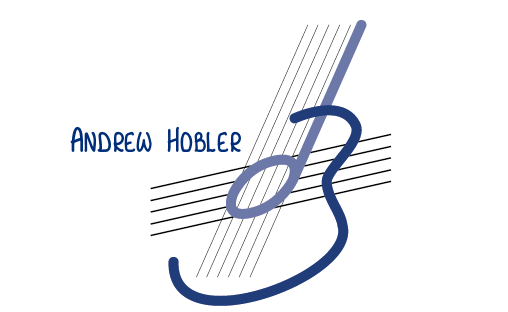MUSIC READING FOR GUITARISTS. WHY BOTHER?
By Andrew Hobler © 2017
The Premise
In my many years of teaching guitar in both a school and private studio, the most difficult is remedial teaching. ‘Fixing’ those things that should have been learned in the early stages.
I was always getting students come for lessons because they had chosen music as a subject in year 9 or 10 and had no music experience apart from playing 4 chord songs!
As part of classroom ensembles and in order to bring them ‘up to speed’ with general class work, I had to do a crash course with them and fit 5 years of training into a month of lessons!
Learning the Basics
Learning the basics of music reading (not TAB!) is essential for understanding the instrument and being able to communicate with other musicians. You do not need to be an expert sightreader (very, very few guitar players ever get to this point), but a good knowledge of the notes in the first position will set up a strong foundation to work from.
This can be done through allowing a little time each day and working on graded, easy material to avoid confusion.
Disaster
Learning only from TAB alone is a recipe for disaster. Note names are rarely learned. Every song is a series of pieced together numbers and fingerings that bear no relationship to what is happening musically.
TAB can have its uses and I certainly use it occasionally to help students to achieve their musical goals and to minimise confusion. Unfortunately, it has become the only way that some people choose to learn or play music and this potentially inhibits a great deal of musical accomplishment.
Geniuses
There are genius musicians who require neither TAB, or music reading ability. These musicians rely solely on their musical ear and technical skills. If they are genius players who are gifted with the ability to hear and reproduce the sounds they are hearing, or are able to arrange music on their instrument by sound alone, they will probably produce some amazing results. These players are very much in the minority.
A good teacher will recognise this ability early on and foster the student’s interest and curiosity without stifling their innate musical sense.
Where did it all go wrong?
Learning to read standard music notation (the type of music notation, for instance, that pianists and horn players read), has become less widespread among guitar players. TAB, the internet, youtube etc have lessened the student’s reliance on standard music. Many guitar teachers don't read music and so their students don't learn how to read it either.
A Simple System
If the student is young (Grade 4 to Grade 7), basic music reading is a good place to start. It is less painful for the fingers than chord playing and students learn about the elements of music in this way. It is also easier for them to recognise what they are playing rather than just have the sound of the chord sequences in a song.
Once a student reaches about 13 and wants to begin on guitar, it is much harder to get them to read the music. I think this is because the books and materials that have been prepared to help students learn to read music must start and a very basic level.
In other words, ‘the songs won’t be particularly cool’. The simple nature of the songs in music reading books for guitar is necessary to enable the young student to progress without confusion or frustration. Music reading is a skill that takes practice, and has a very important use in music making although most guitarists don’t want to put the time in to learn it.
A carefully graded course in the basics of music reading such as Music Reading for Guitar (available from www.andrewhobler.com) provides the basics of music reading for students who have some developed technical skill but assumes no knowledge of music or the notes on the guitar.
Chord Charts
The ability to read and write basic chord charts is essential as it allows us to record music in written form.
Chord chart reading is an essential skill. (More so than single note reading). The rhythmic aspects of reading music allow us to pick up a chord chart and be well on the way to turning it into music in a short time if we understand the details written on the music. Contemporary guitar players mainly need to develop a functional knowledge of theory, a great ear, solid rhythm, a vocabulary of licks, and a strong understanding of different styles.
